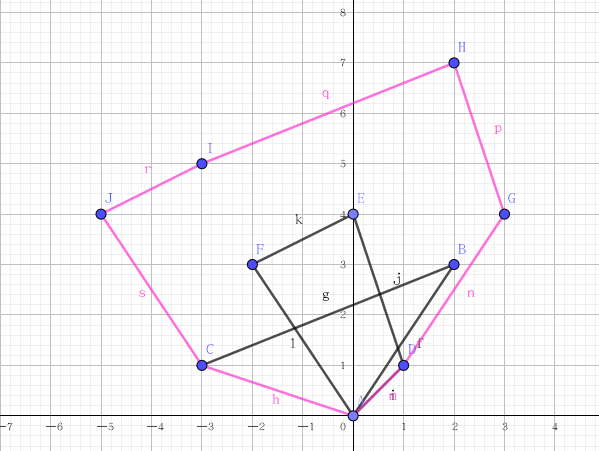1
2
3
4
5
6
7
8
9
10
11
12
13
14
15
16
17
18
19
20
21
22
23
24
25
26
27
28
29
30
31
32
33
34
35
36
37
38
39
40
41
42
43
44
45
46
47
48
49
50
51
52
53
54
55
56
57
58
59
60
61
62
63
64
65
66
67
68
69
70
71
72
73
74
75
76
77
78
79
80
81
82
83
84
85
86
87
88
89
90
91
92
93
94
95
96
97
98
99
100
101
102
103
104
105
106
107
108
109
110
111
112
113
114
115
116
117
118
119
120
121
122
123
124
125
|
#include <bits/stdc++.h>
using namespace std;
typedef long long ll;
#define endl '\n'
const int maxn = 2e5+10;
double eps = 1e-9;
struct Tpoint{
double x,y,z;
Tpoint(double x = 0,double y = 0,double z = 0):x(x),y(y),z(z){}
};
int npoint,nouter;
Tpoint pt[maxn],outer[4],res;
double radius,tmp;
inline double dist(Tpoint p1,Tpoint p2){
double dx = p1.x - p2.x,dy = p1.y - p2.y,dz = p1.z - p2.z;
return (dx*dx + dy*dy + dz*dz);
}
inline double dot(Tpoint p1,Tpoint p2){
return p1.x*p2.x + p1.y*p2.y + p1.z*p2.z;
}
void ball(){
Tpoint q[3];double m[3][3], sol[3],L[3],det;
res.x = res.y = res.z = radius = 0;
switch(nouter){
case 1: res = outer[0];break;
case 2:
res.x = (outer[0].x+outer[1].x)/2;
res.y = (outer[0].y+outer[1].y)/2;
res.z = (outer[0].z+outer[1].z)/2;
radius = dist(res,outer[0]);
break;
case 3:
for(int i = 0;i < 2;i++){
q[i].x = outer[i+1].x - outer[0].x;
q[i].y = outer[i+1].y - outer[0].y;
q[i].z = outer[i+1].z - outer[0].z;
}
for(int i = 0;i < 2;i++)
for(int j = 0;j < 2;j++)m[i][j] = dot(q[i],q[j])*2;
for(int i = 0;i < 2;i++)sol[i] = dot(q[i],q[i]);
if(fabs(det = m[0][0]*m[1][1] - m[0][1]*m[1][0])<eps)return;
L[0] = (sol[0]*m[1][1] - sol[1]*m[0][1])/det;
L[1] = (sol[1]*m[0][0] - sol[0]*m[1][0])/det;
res.x = outer[0].x + q[0].x*L[0] + q[1].x*L[1];
res.y = outer[0].y + q[0].y*L[0] + q[1].y*L[1];
res.z = outer[0].z + q[0].z*L[0] + q[1].z*L[1];
radius = dist(res,outer[0]);
break;
case 4:
for(int i = 0;i < 3;i++){
q[i].x = outer[i+1].x - outer[0].x;
q[i].y = outer[i+1].y - outer[0].y;
q[i].z = outer[i+1].z - outer[0].z;
sol[i] = dot(q[i],q[i]);
}
for(int i = 0;i < 3;i++)
for(int j = 0;j < 3;j++)m[i][j] = dot(q[i],q[j])*2;
det = m[0][0] * m[1][1] * m[2][2]
+ m[0][1] * m[1][2] * m[2][0]
+ m[0][2] * m[2][1] * m[1][0]
- m[0][2] * m[1][1] * m[2][0]
- m[0][1] * m[1][0] * m[2][2]
- m[0][0] * m[1][2] * m[2][1];
if(fabs(det) < eps)return;
for(int j = 0;j < 3;j++){
for(int i = 0;i < 3;i++)m[i][j] = sol[i];
L[j] = (m[0][0] * m[1][1] * m[2][2]
+ m[0][1] * m[1][2] * m[2][0]
+ m[0][2] * m[2][1] * m[1][0]
- m[0][2] * m[1][1] * m[2][0]
- m[0][1] * m[1][0] * m[2][2]
- m[0][0] * m[1][2] * m[2][1]
)/det;
for(int i = 0;i < 3;i++)m[i][j] = dot(q[i],q[j])*2;
}
res = outer[0];
for(int i = 0;i < 3;i++){
res.x += q[i].x * L[i];
res.y += q[i].y * L[i];
res.z += q[i].z * L[i];
}
radius = dist(res,outer[0]);
}
}
void minball(int n){
ball();
if(nouter < 4){
for(int i = 0;i < n;i++){
if(dist(res,pt[i]) - radius > eps){
outer[nouter] = pt[i];
++nouter;
minball(i);
--nouter;
if(i > 0){
Tpoint Tt = pt[i];
memmove(&pt[1],&pt[0],sizeof(Tpoint)*i);
pt[0] = Tt;
}
}
}
}
}
double smallest_ball(){
radius = -1;
for(int i = 0;i < npoint;i++){
if(dist(res,pt[i]) - radius > eps){
nouter = 1;
outer[0] = pt[i];
minball(i);
}
}
return sqrt(radius);
}
signed main(){
cin >> npoint;
for(int i = 0;i < npoint;i++){
int x,y,z;
cin >> x >> y >> z;
pt[i] = Tpoint(x,y,z);
}
printf("%.10lf",smallest_ball());
return 0;
}
|
